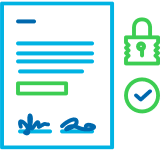
BY RYAN TULLY
June 30, 2023
Maintaining compliance with the Gramm-Leach-Bliley Act (GLBA) is of paramount importance for financial services organizations. This comprehensive checklist outlines the key GLBA compliance requirements across three major sections: The Financial Privacy Rule, the Safeguards Rule, and the Pretexting Provisions.
By understanding and adhering to these regulations, financial institutions can protect customer data and maintain trust in an increasingly data-driven world. Additionally, this guide will explore the role of data discovery, dark data, and compliance in ensuring robust data protection strategies.
Section 1: The Financial Privacy Rule
The Financial Privacy Rule constitutes an essential part of GLBA compliance. Its primary goal is to ensure that financial institutions inform customers about their privacy practices and provide them with the right to opt out of certain data sharing activities. To comply with this rule, financial organizations should:
1.1. Provide Clear Privacy Notices: Financial institutions must develop comprehensive privacy notices that clearly outline the types of information collected, the purposes of collection, and the entities with which data is shared. These notices must be easily accessible to customers.
1.2. Offer Opt-Out Mechanisms: Financial institutions must provide customers with the opportunity to opt out of having their information shared with non-affiliated third parties. This opt-out mechanism should be simple and readily available to customers.
1.3. Safeguard Personally Identifiable Information (PII): Organizations should implement robust security measures to protect customers’ PII. Encryption, access controls, and regular security audits are crucial to ensure data protection.
1.4. Train Employees on Privacy Policies: Financial institutions should educate their employees about privacy policies and procedures to ensure consistent adherence to the Financial Privacy Rule. Regular training programs can help employees stay up to date with evolving privacy requirements.
1.5. Conduct Periodic Privacy Policy Reviews: Regular reviews of privacy policies enable financial institutions to ensure ongoing compliance with the Financial Privacy Rule. As regulations evolve, organizations must adapt their policies accordingly to protect customer privacy effectively.
Section 2: The Safeguards Rule
The Safeguards Rule under GLBA mandates financial institutions to develop and implement comprehensive security programs to protect customer information. Adhering to the Safeguards Rule involves the following key steps:
2.1. Identify and Assess Information Risks: Financial organizations should conduct thorough assessments to identify the types of customer information they collect and evaluate associated risks. This assessment helps in determining the appropriate security measures to implement.
2.2. Develop and Implement Security Policies: Financial institutions should create comprehensive security policies and procedures that address risks identified during the assessment. These policies should cover areas such as data access controls, employee training, incident response, and vendor management.
2.3. Designate a Security Officer: Appointing a dedicated security officer responsible for overseeing the implementation of security programs and ensuring compliance with the Safeguards Rule is essential. The security officer should have the necessary authority and resources to carry out their duties effectively.
2.4. Regularly Monitor and Test Security Systems: Financial organizations should regularly monitor and test their security systems to identify vulnerabilities or weaknesses. This includes conducting internal and external security audits, penetration testing, and vulnerability assessments.
2.5. Implement Vendor Management Controls: Financial institutions must establish robust controls for managing third-party vendors that have access to customer information. This includes conducting due diligence during vendor selection, incorporating contractual safeguards, and monitoring vendor compliance with security requirements.
Section 3: The Pretexting Provisions
The Pretexting Provisions of GLBA aim to prevent the unauthorized acquisition and use of customer information through false pretenses. Financial institutions can ensure compliance with these provisions by implementing the following measures:
3.1. Establish Employee Authentication Procedures: Financial organizations should implement strong authentication protocols to verify the identity of employees accessing customer information. Multi-factor authentication and access controls based on job roles and responsibilities can enhance security.
3.2. Implement Data Access Controls: Limiting access to customer information to authorized individuals reduces the risk of unauthorized acquisition. Role-based access controls, strict password policies, and monitoring user activity help prevent pretexting attacks.
3.3. Conduct Regular Employee Training: Educating employees about the risks of pretexting and providing guidance on recognizing and reporting suspicious activities is crucial. Training programs should cover social engineering tactics, phishing awareness, and incident response protocols.
3.4. Monitor and Detect Suspicious Activities: Financial institutions should implement robust monitoring systems to identify and respond to suspicious activities promptly. Advanced analytics and intrusion detection systems can help detect unauthorized access attempts and potential pretexting incidents.
3.5. Establish Incident Response Plans: Having well-defined incident response plans in place enables financial organizations to respond effectively to pretexting incidents. These plans should include steps for containment, investigation, notification, and remediation in the event of a security breach.
Enable your information security team to do their best work
After fully understanding the three sections of the GLBA, the next step on your checklist is to make implementation easier for your organization’s security team. Here are the best practices for enabling your security team to perform at peak efficiency.
Create a privacy-forward company culture
Company leaders need to advocate for ongoing security training. When your organization’s entire team is knowledgeable about best practices, compliance basics, and the actions that should raise red flags, you are in a better position to prevent potential instances of fraud, cyber hacking, or private data leaks. Training and education are critical and should come not only from the organization’s security team, but from the C-suite on down.
Automate wherever possible
Security teams are often inundated with hours and hours of manual tasks. This bogs down teams and wastes your organization’s most valuable resource: time. By making the smart investment in software that automates important, yet time-consuming tasks like sensitive data discovery, classification and remediation, your security team can spend more time doing strategic work, rather than repetitive tasks that require extra hours.
Streamline GLBA reporting
Reports are an important part of maintaining GLBA compliance. You want thorough, detailed reports so your organization can make the right moves, but you don’t want to slow your security team down by digging for data in multiple places.
When your team has fewer manual tasks, they can spend more time truly understanding the data at hand. This is what leads to decision proposals that can help strengthen your company’s overall security initiatives. For this reason, having one data protection solution that shows your security team everything they need to know on clean, easy-to-navigate dashboards, supplemented with easily generated custom reports as needed, is game-changing.
Choose the right data privacy software for GLBA compliance
For any business that deals heavily in financial activity, GLBA compliance is essential. Not only is it important for regulatory and financial reasons, but it’s essential for your organization’s reputation. When you take the time to protect your customers’ data, you show that you care — which is critical for earning trust from your customers and potential customers.
Spirion Sensitive Data Platform makes it easier for businesses to take control of GLBA compliance.
